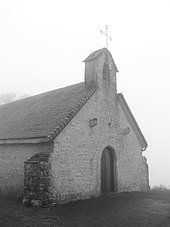Échevannes (Doubs)
| Échevannes | ||
|---|---|---|
|
|
||
| region | Bourgogne-Franche-Comté | |
| Department | Doubs | |
| Arrondissement | Besançon | |
| Canton | Ornans | |
| Community association | Loue-Lison | |
| Coordinates | 47 ° 4 ' N , 6 ° 14' E | |
| height | 550-747 m | |
| surface | 5.23 km 2 | |
| Residents | 89 (January 1, 2017) | |
| Population density | 17 inhabitants / km 2 | |
| Post Code | 25580 | |
| INSEE code | 25211 | |
Échevannes is a French commune with a population of 89 (as at 1st January 2017) in the Doubs department in the region of Bourgogne Franche-Comté .
geography
Échevannes is located at 650 m above sea level, seven kilometers east-southeast of Ornans and about 24 kilometers southeast of the city of Besançon (as the crow flies). The village extends in the Jura , to the west of the Valdahon plateau, in a panoramic position high above the Loue valley floor .
The area of the 5.23 km² large municipality covers a section of the French Jura. The main part of the area is taken up by the high plateau of Valdahon, which is an average of 650 m. It is mainly made up of arable and meadow land, partly also of forest, and gradually rises towards the southeast. The plateau has no above-ground watercourses because the rainwater seeps into the karstified subsoil. At 747 m, the highest point in Échevannes is reached on the summit of the Signal de Cudrey . The western demarcation mostly runs along the upper edge of the slope, crowned by a ledge and sloping steeply into the Loue valley. The striking protrusion of the plateau between the valleys of Loue and Ruisseau de Vaux is also part of Échevannes.
Neighboring communities of Échevannes are Lavans-Vuillafans in the north and east, Lods in the south and Vuillafans in the west.
history
The place name originated from the agglutination of es (today French aux ) and chevannes , which is derived from the Latin word capana (house, hut), and thus means for houses . In the Middle Ages, Échevannes was part of the Durnes domain . Together with Franche-Comté , the village came to France with the Peace of Nijmegen in 1678. Today Échevannes is a member of the Loue-Lison community association .
Attractions
The Sainte-Gertrude chapel was built in the 15th century and features a flamboyant style portal. Various farmhouses in the characteristic style of Franche-Comté from the 18th and 19th centuries have been preserved in the town center.
population
| Population development | |
|---|---|
| year | Residents |
| 1962 | 64 |
| 1968 | 45 |
| 1975 | 49 |
| 1982 | 80 |
| 1990 | 71 |
| 1999 | 64 |
| 2006 | 84 |
| 2016 | 89 |
With 89 inhabitants (January 1, 2017) Échevannes is one of the smallest municipalities in the Doubs department. After the population had decreased markedly in the first half of the 20th century (114 people were counted in 1881), population growth has been recorded again since the beginning of the 1970s.
Economy and Infrastructure
Until well into the 20th century, Échevannes was mainly a village characterized by agriculture (arable farming, fruit growing and cattle breeding) and forestry. Even today, the residents live mainly from their work in the first sector. Outside of the primary sector there are almost no jobs in the village. Some workers are also commuters who work in the surrounding larger towns.
The village is off the main thoroughfares on a departmental road that leads from Valdahon to Vuillafans.
literature
- Le Patrimoine des Communes du Doubs. Volume 2, Flohic Editions, Paris 2001, ISBN 2-84234-087-6 , pp. 838-839.

